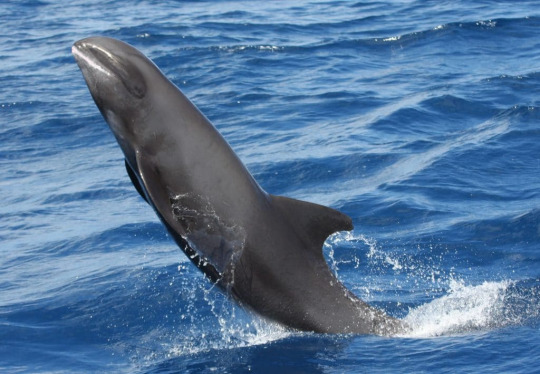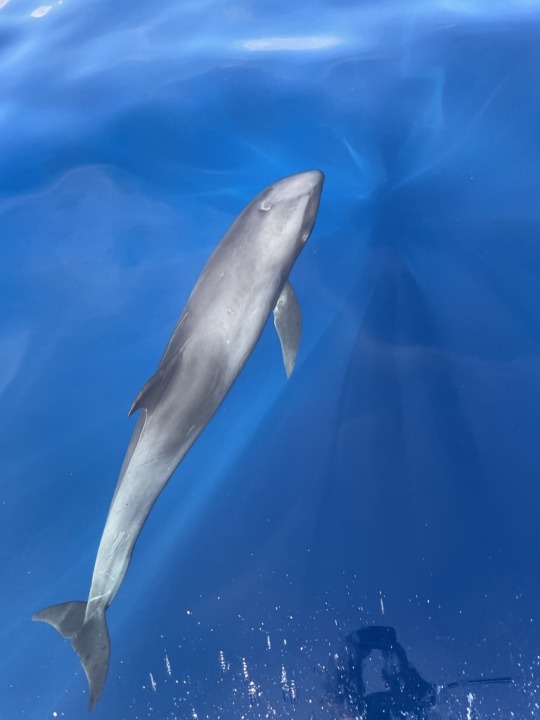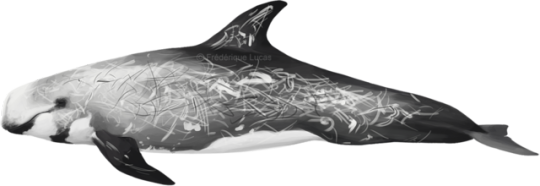#Peponocephala electra
Explore tagged Tumblr posts
Text

Melon-headed whale Peponocephala electra
Observed by kenny_well, CC BY-NC
#Peponocephala electra#melon-headed whale#Cetacea#Delphinidae#cetacean#dolphin#whale#Asia#Indonesia#Pacific Ocean#Flores Sea
92 notes
·
View notes
Text
Animal of the Day!
Melon-headed Whale (Peponocephala electra)

(Photo from Whale & Dolphin Conservation USA)
Conservation Status- Least Concern
Habitat- Tropical Pacific Ocean; Tropical Atlantic Ocean
Size (Weight/Length)- 2.5 m
Diet- Fish; Cephalopods; Shrimp
Cool Facts- Named after their rounded head, the melon-headed whale lives in mass groups of up to 500 individuals and sometimes growing to over 2,000 whales. These mega pods have smaller, female-led family units within them while males travel from one giant pod to another. Melon-headed whales occasionally travel with other porpoises like Fraser’s dolphins and bottlenose dolphins along with pilot whales. Female whales give birth only once every 4 years after a 12 month pregnancy. Sadly, melon-headed whales are threatened by pollution, human hunting, bycatch, and noise. These whales have tight knit pod structures, resulting in mass beaching due to interruption of their sonar. Luckily, many of these stranded pods are saved by volunteers and authorities working to move the whales back into deeper water .
Rating- 12/10 (Cantaloupe, watermelon, cucamelon, honeydew…)
#animal of the day#animals#whales#mammals#porpoise#thursday#july 27#melon-headed whale#biology#science#conservation#the more you know
113 notes
·
View notes
Text
ROUND ONE PART TWO

[ID: A photo of a melon-headed whale underwater and a photo of a Southern right whale underwater, with a VS symbol between them. End ID.]
All toothed whales have a fleshy organ in their head called a melon, but for some reason, the melon-headed whale (who sports the very fun scientific name of Peponocephala electra) is deemed the definitive holder of the melon. The Southern right whale is one of three species of right whale (and not the last you’ll see here!), and is easily the most abundant. Those rough white patches on their heads are called callosities, and their pattern is unique to every whale!
Photo credit to Cyril di Bisceglie and Phillip Colla.
7 notes
·
View notes
Photo

The Eclectic Electra
Alright then. One last illustration, one last far-fetched alliteration. Couldn’t bear to leave the lonely Melon-headed whale unpublished just because I hadn’t thought to put it in with any of the others. Not just for completionist reasons, but also because they’re very nice dolphins and I like how this illustration turned out. I got my fair share of Melon-headed whales (or “peps”, as the client called them) in my painting “As above, so is below” which holds no less than 57 unique individuals. And unique they are, with their long, pointy pectoral fins, quite severely dipping cape, and funny blunt heads with huge bandit masks. I think they have a friendly look to them.
Their scientific name is interesting too. Genus Peponocephala was created in 1966 by Nishiwaki and Norris, however the scientists made a small mistake. They thought “Pepo” meant melon, but in fact it translates to pumpkin. Wrong fruit. So, the Pumpkin-headed whale then. Nonetheless the name has been accepted and the common name kept intact. What the beautiful specific name electra refers to (they are also known as the Electra dolphin) is less certain. Most likely one of two Electras in Greek mythology; favour falls to Electra the daughter of Agamemnon who mourns her slain father. Perhaps the dolphin’s dark colours and “cape” on the back reminded of someone in mourning.
#illustrations#scientific illustration#pumpkin-headed whale#I mean#melon-headed whale#Peponocephala electra#Peponocephala#electra#dolphin#odontocete#digital art
51 notes
·
View notes
Photo

A wild “wholfin,” the hybrid offspring of a melon-headed whale (Peponocephala electra), and a rough-toothed dolphin (Steno bredanensis) swimming next to a melon-headed whale (top) near Kauai, Hawaii.
#queue#found#Peponocephala electra x Steno bredanensis#hybrid#hybrids#hybrid dolphin#hybrid dolphins#Peponocephala electra#melon-headed whale#melon-headed whales#oceanic dolphin#oceanic dolphins#Delphinidae#delphinid#delphinids#dolphin#dolphins#toothed whale#toothed whales#Odontoceti#odontocete#odontocetes#Cetacea#cetacean#cetaceans#mammals#Animalia#animal#animals#upload
3 notes
·
View notes
Photo

This photo posted by BFAR in its Facebook page shows rescuers treating the wounds of the female Whale that was stranded in the sea waters of Salcedo town in Eastern Samar. After the treatment and documentation, the mammal was released back to the sea on January 10, 2017. Photo: BFAR
Philippines: Wounded Whale rescued in Eastern Samar By Ricky J. Bautista, 13th January ;
A wounded Melon-headed Whale (Peponocephala electra) stranded in Salcedo town in Eastern Samar was rescued and returned back to sea, the Bureau of Fisheries and Aquatic Resources (BFAR) regional office reported.
The BFAR said the local folk who discovered the Whale stranded in the seashore of Barangay Butig, Salcedo town around 9 a.m. of January 10 immediately alerted the authorities.
According to the first responders' account, the Whale was seen swimming erratically near the shore of said village and was being followed by fishermen.
Sensing that the Whale might be in danger of being slaughtered, the unidentified concerned citizen sought help from Port Kennedy. Fearing the Whale will be killed and consumed, they brought the Whale on shore and called for assistance.
The rescuers said the Whale, measuring to about 2.5 meters in length and 1.25 girth at its fins, was very weak, stressed and had several contusions even in the eyes.
The BFAR team immediately treated the wounds. After four hours of treatment, the Whale was released back to sea, off Pearl Island in Guiuan, Eastern Samar.
"The release was considered successful by the rescuers, as the whale was observed to be strong again and swim faster than it was found stranded," said one of the BFAR personnel.
Source: Sun.Star
#melon-headed whale#Peponocephala electra#dolphins#Delphinidae#whales and dolphins#cetaceans#Cetacea#Cetartiodactyla#Artiodactyla#Odontoceti#toothed whales#mammals#marine mammals#marine#Philippines#Visayas#Eastern Visayas#Eastern Samar#Samar#wildlife rescue#Sun.Star
1 note
·
View note
Photo

Delfín cabeza de melón (Peponocephala electra) 🐬🍈🌊 Se trata de una especie de cetáceo odontoceto de la familia Delphinidae que habita en todas los océanos tropicales y subtropicales. Es de hábitos pelágicos, es decir, se desplazan en aguas medias o cerca de la superficie. En cuanto a sus características, según Oceana, debido a la ausencia de un hocico prolongado, que suele caracterizar a la especie, el delfín cabeza de melón suele ser confundido con distintas especies de ballena, sin embargo, esta especie es muy sociable y se reúne en manadas de más de 100 individuos. Las aletas son relativamente largas, se estima que representan aproximadamente el 20% de la longitud del cuerpo. Son suavemente curvados y puntiagudos al final, esto crea una distinción obvia de las aletas redondeadas de las orcas pigmeas. Se sabe poco sobre la temporada de reproducción, sin embargo, parece alcanzar su punto máximo a principios de la primavera en las latitudes bajas de ambos hemisferios o en julio y agosto en las latitudes más altas. 📷 Oceana https://www.instagram.com/p/CDo_DVcFsh3/?igshid=1mblntmh6oegq
0 notes
Text
Centinaia di delfini sono morti sulla spiaggia di Capo Verde: inutili le operazioni fatte per salvarli
Centinaia di delfini sono morti sulla spiaggia di Capo Verde: inutili le operazioni fatte per salvarli

Quasi 200 delfini della specie Peponocephala electra si sono arenati lo scorso martedì sulla spiaggia di Altar e Ponta de Antónia dell’isola di Capo Verde Boa Vista.
Grazie alla collaborazione di cittadini e autorità, 163 animali ancora vivi sono stati riportati in mare, ma lo sforzo di salvare gli animali è stato vano: la maggior parte dei delfini si è nuovamente arenata.
I corpi senza vita…
View On WordPress
#passionevegano#200#animali#Capo#capo verde#centinaia#cittadini#delfini#delfini spiaggiati#fatte#hanno#inutili#mare#morti#news#notizie#operazioni#passione vegano#ricette#rumors#salvarli#spiaggia#vegan#vegano#verde
0 notes
Text
For the first time, scientists have seen dolphins adopt an orphan from another species
https://sciencespies.com/nature/for-the-first-time-scientists-have-seen-dolphins-adopt-an-orphan-from-another-species/
For the first time, scientists have seen dolphins adopt an orphan from another species

Bottlenose dolphins are attentive and flexible parents: The very survival of their calves depends on it. And in some rare cases, their adopted offspring, too. For the first time ever, scientists have witnessed a mother dolphin caring for the orphan of another species as though it were hers.
For more than three years, researchers in French Polynesia have tracked this unusual bottlenose dolphin (Tursiops truncatus) as she raises a melon-headed whale calf (Peponocephala electra) along with what appears to be her own biological newborn.
The unique case is unprecedented in dolphins as far as we are aware, and it’s only the second example of cross-genus adoption ever documented in wild animals. The other case was reported back in 2006, when primatologists spotted two capuchin monkey mothers raising a baby marmoset.
Two parents, however, make such an adoption more manageable. But bottlenose dolphins give birth to one calf at a time and care for that baby for up to six years. So adopting another calf on top of that is a massive constraint on both the mother and her real biological offspring.

(Carzon et al., Ethology, 2019)
“A female who, in addition to her own calf, takes care of a heterospecific [from a different species] baby, is something very surprising,” says lead researcher Pamela Carzon, who works at the Groupe d’Étude des Mammifères Marins (GEMM) in Tiputa, French Polynesia.
Bottlenose dolphins do sometimes ‘kidnap’ calves from another species. But these misplaced young are usually adopted by females who couldn’t raise their own, and they tend to disappear shortly after.
Within a community of bottlenose dolphins at Rangiroa Atoll, however, something inexplicable is going on. In 2014, an adult female dolphin was photographed with her presumed first offspring; just two months later, an unusual, one-month-old “short‐beaked” calf joined her ranks.

(Carzon et al., Ethology, 2019)
Given that the mother dolphin already had her own young, researchers think it’s unlikely that the new calf was kidnapped. And in the absence of any genetic data, they are as sure as they can be that the calf is not some sort of dolphin-whale hybrid.
“The second calf was documented as male; it possessed a slender profile, rounded head and blunt rostrum, pointed pectoral fins, dark pigmentation and whitish patterns between the throat and urogenital area – all morphological characteristics of a melon‐headed whale,” the authors write.
A year later, the researchers clearly observed the whale calf nursing from its foster mother and swimming in a typical infant position beneath her. What’s more, on multiple occasions, the intruder calf was filmed pushing its dolphin sibling away from its own mother’s belly.
Between the end of 2015 and the beginning of 2016, the biological calf disappeared. No one can say for sure what happened to it or why, but the researchers suggest it could be related to competition with the second calf, leading to deficient maternal care.
“It is very difficult to explain such behaviour, especially since we have no information on how the melon-headed whale newborn was separated from his natural mother,” explains Carzon in a recent video.

(Carzon et al., Ethology, 2019)
The reasons for this exceptional adoption may have to do with the dolphin’s inexperience as a mother. Plus, her general friendliness towards human divers could also have made her more tolerant to other species, so It’s possible that another female kidnapped the newborn, and then this specific mother accepted it.
An outside expert told National Geographic it was all about timing.
“Most likely, it was just a perfect moment for this calf to come along, when [the mother] was at a very receptive period to forming those bonds with her own offspring, and it led to this slightly wacky situation,” Kirsty MacLeod, a behavioural ecologist at Lund University, told Erica Tennenhouse.
Still, the mother isn’t entirely to blame for this species mix-up. While she never showed ambivalence to the intruder, from what the divers could tell, the orphan whale was quite persistent in initiating and maintaining this odd mother-child interaction.
“It seems the young melon-headed whale has been well integrated into his adoptive community, and adopts behaviour consistent with those of his adopted group: he surfs and jumps with the bottlenose dolphins, he socialises with young bottlenose males and females, and seems to communicate with other members of the community,” says Carzon.
“If he comes to the age of weaning, it’s very likely that he’ll live a bottlenose dolphin life.”
The research has been published in Ethology.
#Nature
0 notes
Photo

Melon-headed whale Peponocephala electra
Observed by kdlafferty, CC BY-NC
#Peponocephala electra#melon-headed whale#Cetacea#Delphinidae#cetacean#dolphin#whale#Oceania#United States#Palmyra Atoll#Pacific Ocean
29 notes
·
View notes
Photo




302) Melonogłów wielozębny, delfin grubogłowy, melon-headed whale , melon-headed dolphin, many-toothed blackfish, melon whale, electra dolphin (Peponocephala electra) – gatunek ssaka z rodziny delfinowatych (Delphinidae). Takson po raz pierwszy opisany przez J. E. Graya w 1846 roku pod nazwą Lagenorhynchus electra. Autor nie określił miejsca typowego. Jedyny przedstawiciel rodzaju melonogłów (Peponocephala) utworzonego przez M. Nishiwakiego i K. S. Norrisa w 1966 roku.
0 notes
Text
Whales

The waters around the Cape Verde islands are rich in various plants and animals. Cetaceans (whales and dolphins) also occur in this part of the Atlantic Ocean. There are 24 different species of whales and dolphins in the waters around Cape Verde. Common species include: the minke whale (Balaenoptera acutorostrata), pygmy whale (Feresa attenuate), white-lipped dolphin (Peponocephala electra),…
View On WordPress
0 notes
Text
Some aspects of the biology of Peponocephala electra (Cetacea: Delphinidae). II. Parasites
http://dlvr.it/PNgv9L
0 notes
Photo







Cetaceans of Nicaragua Part II
And here’s the second part of the Nicaragua commission, making 16 species in total. You may think the baleen whales look familiar and you’d be right, since they’re all based on the baleen whales I painted for SEAMMO. The blackfish however are originals and man am I happy with them. Collectively they’re such incredibly fun species to paint, especially since they’re normally seen as just ‘black dolphins.’ Which makes it extra fun to discover their subtle (and quite complex!) marking, and include those in the illustrations.
As before, species names are in the captions, and here is part I of the Nicaragua cetacean series!
#illustrations#Blue whale#Balaenoptera musculus#Bryde's whale#Balaenoptera brydei#Humpback whale#Megaptera novaeangliae#Short-finned pilot whale#Globicephala macrorhynchus#Risso's dolphin#Grampus griseus#False killer whale#Pseudorca crassidens#Melon-headed whale#Peponocephala electra#digital art#artists on tumblr
36 notes
·
View notes
Photo

Smile! It’s Saturday
[x]
#smiling saturday#melon headed whale#peponocephala electra#electra dolphin#little killer whale#many-toothed blackfish#marine mammal
10 notes
·
View notes